
This 1-Ingredient Gluten-Free Buckwheat Bread recipe is an absolute game-changer! I’ve been making it every single week since early 2022, and it never disappoints! It’s incredibly easy, delicious, and super nourishing. I highly recommend throwing a couple of slices in the toaster/oven to create the ultimate avocado toast or as a side dish for dipping into soup. It even makes amazing croutons in a salad!
Since sharing this recipe with our community on social media, it’s become one of our most popular recipes to date. Hundreds of our community members have shared their versions with us on Instagram. Check out our Buckwheat Bread Instagram Highlights to see just a sample of the ones we’ve received, and please make sure to share your own! If you’re in interested in more gluten-free bread recipes, you’ll also love this super fluffy Red Lentil Quinoa Bread!

Ingredient Notes
- Hulled Raw Buckwheat: Buckwheat groats (or kernels) are the hulled seeds of the buckwheat plant. Despite their name containing the word “wheat,” buckwheat is actually gluten-free and makes for a fantastic bread ingredient. These groats are a staple in many Eastern European and Asian cuisines, known for their nutty flavor and versatile use. This Healthy Buckwheat Bread Recipe is a testament to that.
- Water: Tap water is fine to use depending on your location, if the water is heavily chlorinated in your area, you should choose filtered water, as chlorine will impact the fermentation.
- Salt: Either sea salt flakes or table salt works fine. The salt enhances the natural flavor of the buckwheat.
- Poppy and Sesame Seeds: Adds a delightful crunch and visual appeal to the bread. They are optional but highly recommended for an extra touch of flavor and texture. You can top it with any seeds you like.
IMPORTANT: Use ONLY hulled, non-roasted buckwheat for this recipe. Buckwheat flour, unhulled buckwheat, activated buckwheat, or roasted buckwheat will not work in this recipe.
Why You’ll Love This 1-Ingredient Buckwheat Bread Recipe
- Delicious and Dense: It’s absolutely delicious, with a dense, satisfying texture, and gets even better when toasted! Fermentation not only enhances the flavor, but it can improve the bioavailability of certain nutrients in foods. Specifically, the fermentation process can reduce levels of phytic acid, which is known to bind some minerals and reduce their absorption. By breaking down phytic acid, fermentation can make minerals like iron, zinc, and magnesium more available for absorption by the body.
- So Easy: Although the fermentation process takes a bit of time, this recipe is very hands-off and only requires about 10 minutes of actual work. If you use the right kind of buckwheat, a high-speed blender, and follow the instructions, this simple, yeast-free bread recipe is practically foolproof.
- Cost-effective: Good quality, nourishing, gluten-free bread can be quite expensive where we live, often costing around $15 AUD (~ $9.80 USD), whereas this Gluten-Free Buckwheat Bread comes in at under $3.50 AUD (~ $2.30 USD), even when using organic hulled buckwheat.
- Meal-Prep: Easy to prep in advance and can be frozen. I usually keep half fresh, wrapped in a clean kitchen cloth, to consume in the next few days and slice and freeze the rest. Toast when ready to eat, and it’s as good as fresh! This way, you can toast a piece whenever you crave some delicious bread.
What Are the Health Benefits of Buckwheat?
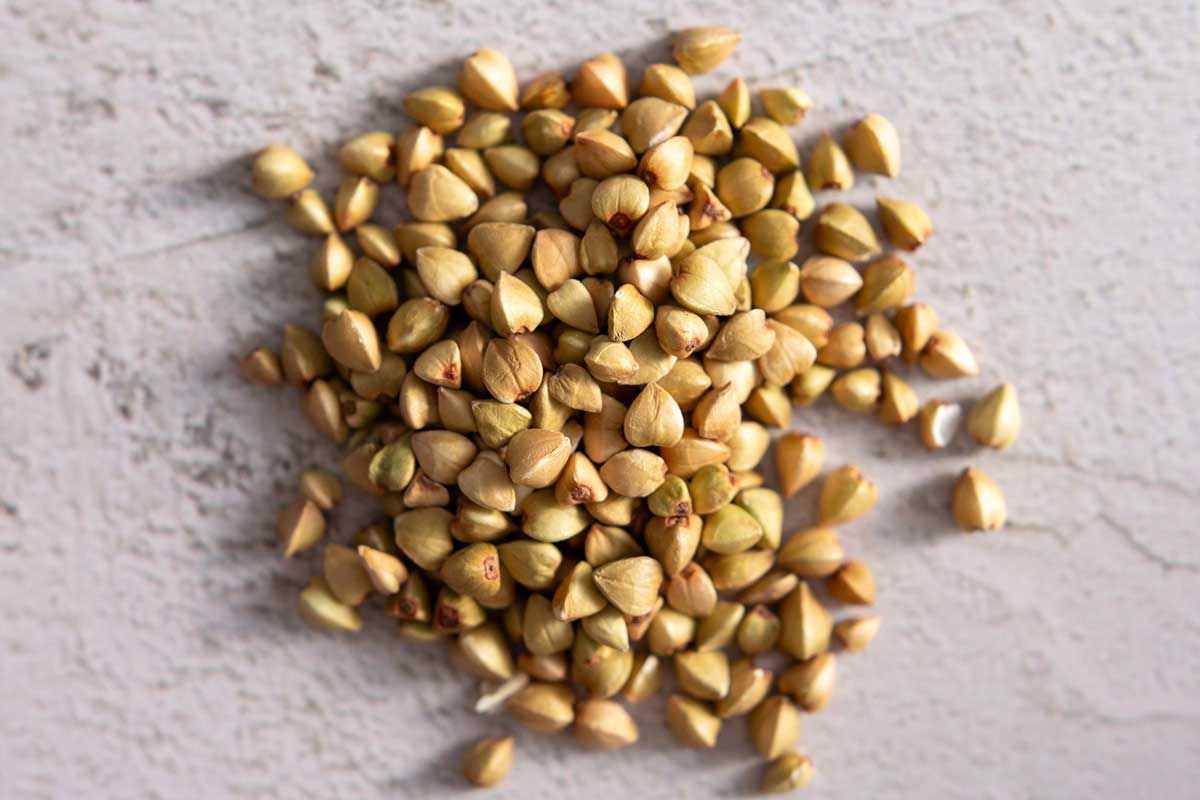
- Buckwheat is highly nutritious, offering a source of fiber and essential minerals, especially magnesium. It’s also packed with antioxidants, particularly rutin, which supports blood vessel health. Despite its name, buckwheat is naturally gluten-free, making it suitable for those with gluten intolerance or celiac disease.
- Buckwheat’s low to medium glycemic index makes it a good choice for those managing blood sugar levels. Plus, its high fiber content aids in digestion.
- Like amaranth or quinoa, these whole grain groats can be cooked like rice or oats, making them a fantastic ingredient for various dishes. From traditional porridge and pilafs to modern salads and even as a rice substitute, buckwheat is incredibly adaptable. It’s also used in making buckwheat flour, a popular alternative for gluten-free baking. We use buckwheat flour to make these High-Protein Buckwheat Pancakes with Blueberry Syrup, and they’re so fluffy and delicious!
Step-by-Step Instructions
Rinse the hulled buckwheat kernels under cold water until clear. After rinsing, soak 17.5 oz (2.6 cups or 500g) of buckwheat in cold water in a large bowl, fully submerged, and cover with a clean cloth for 6 to 7 hours.
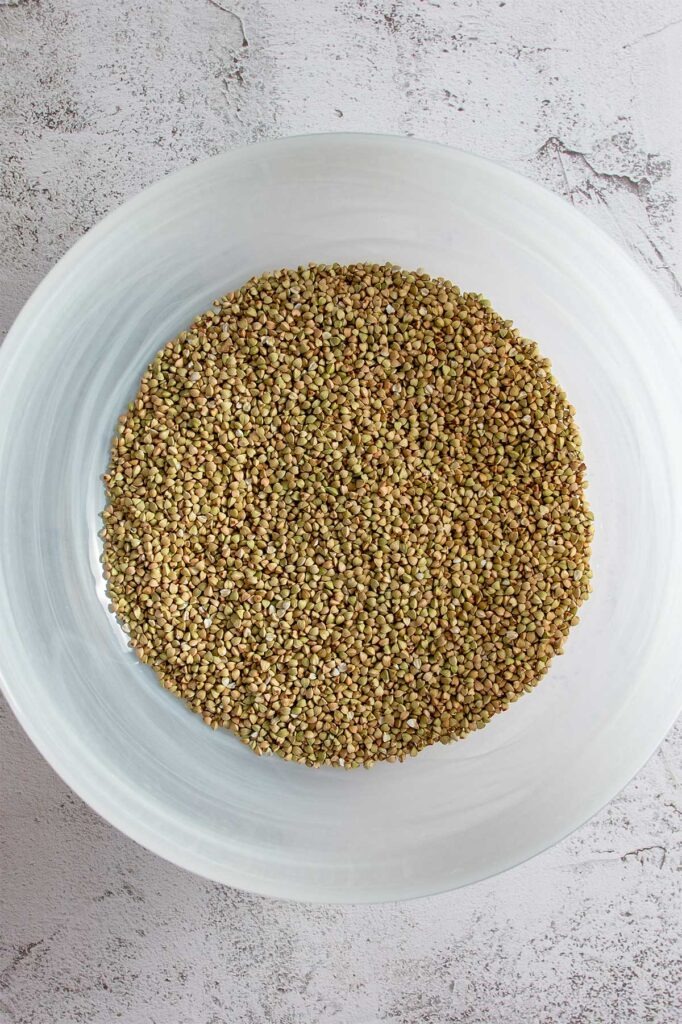

Once soaked, drain the remaining water, but do not rinse.


Transfer to a blender with 6.8 fl oz (0.9 cups or 200 ml) of water and ¼ tsp salt. Blend, starting at low speed and slowly increasing, until you get a very smooth texture without any pieces left. Pour the blended buckwheat mixture back into the bowl.
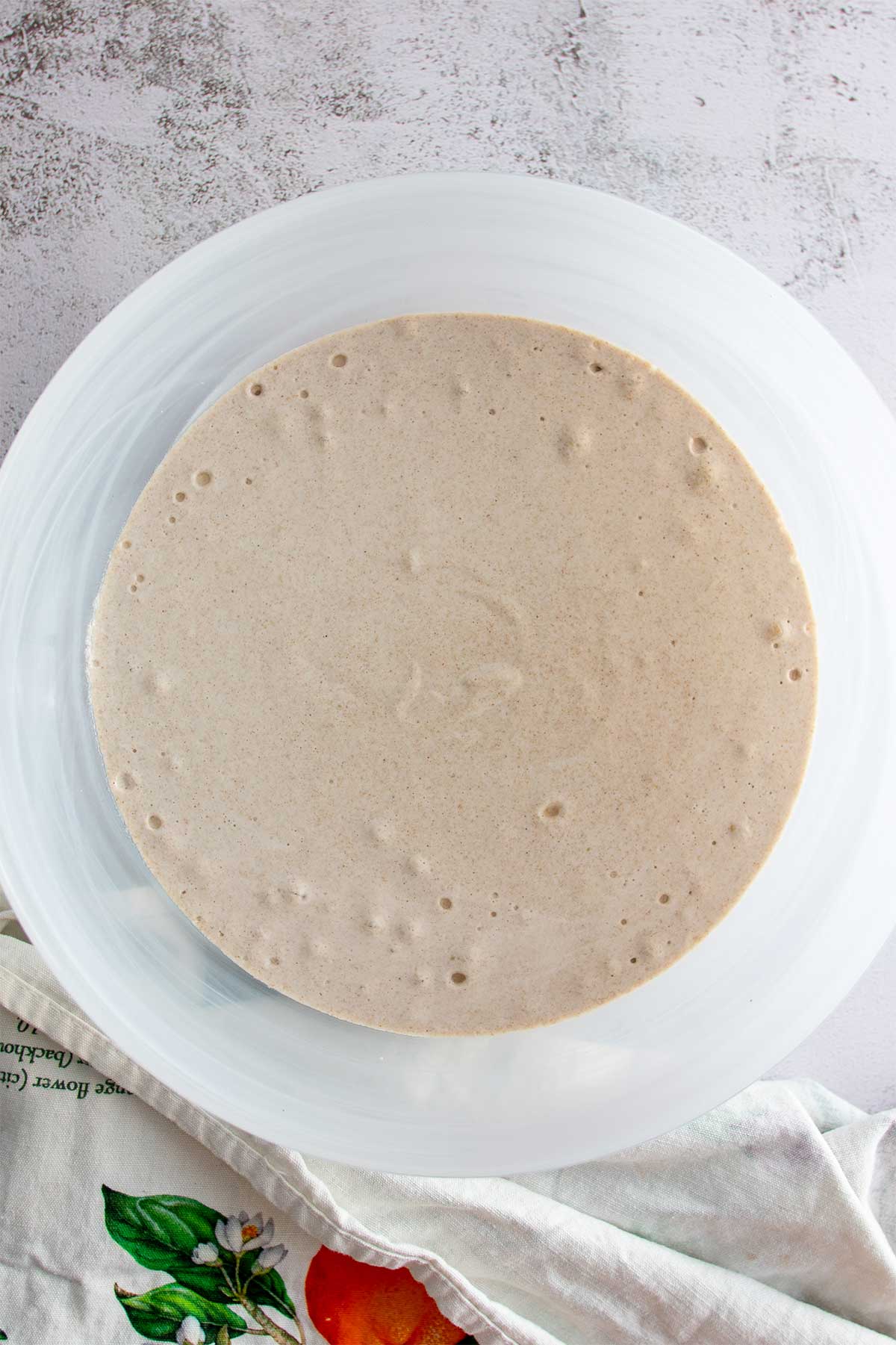
Cover it again and let it sit at room temperature for 12 to 24 hours to ferment. Please check the fermentation table below to confirm the time required based on your current climate.
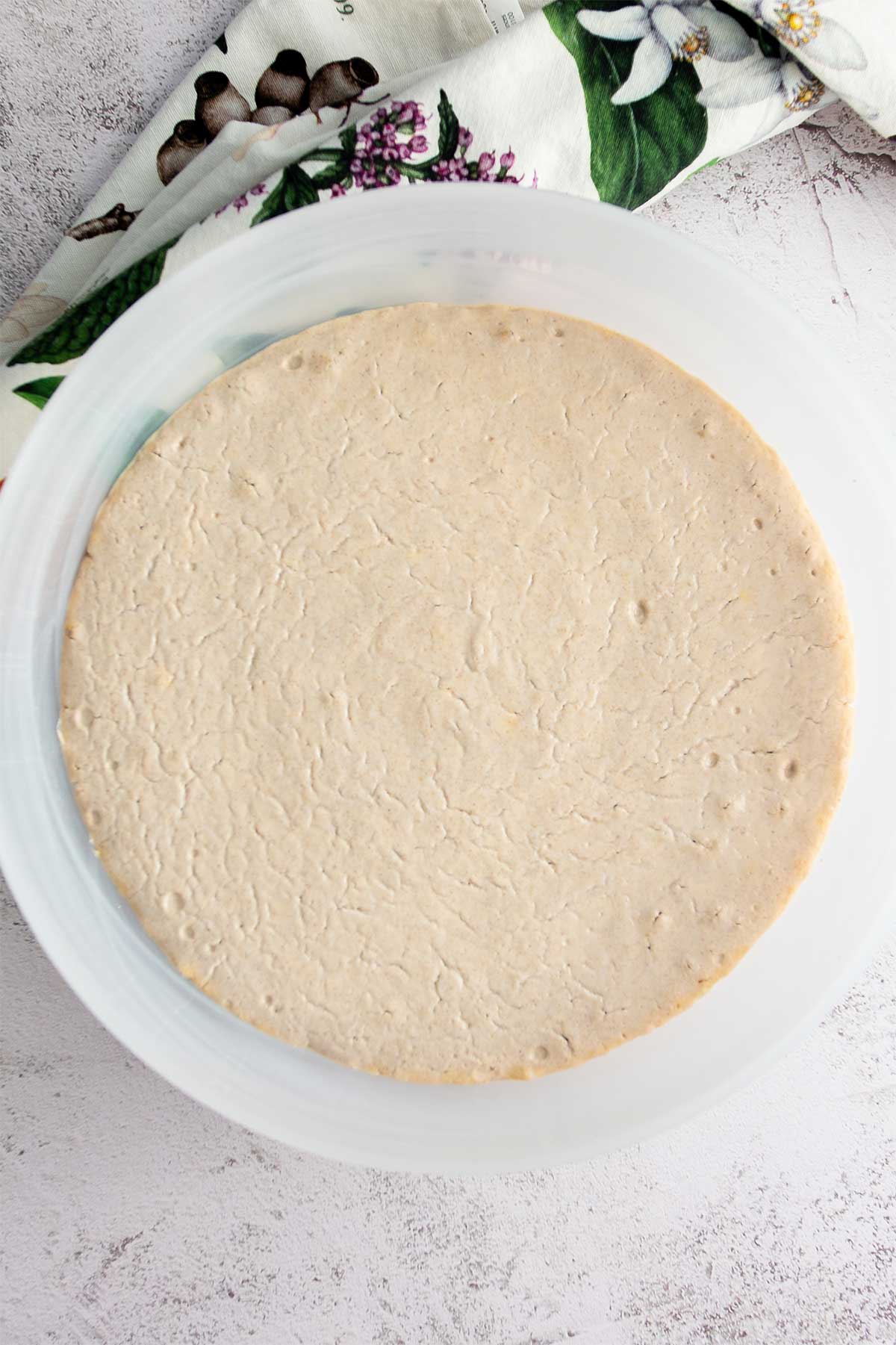

When you’re ready to bake, preheat your oven to 350°F. Line a loaf pan with baking paper and pour the fermented buckwheat dough into the pan. If you’d like, sprinkle the top with 2 tsp of poppy and sesame seeds (or whichever toppings you’d like).


Bake the bread in the preheated oven for 90 minutes. The bread should be golden brown and firm to the touch.


Allow the bread to cool down before slicing. This makes it easier to cut and improves the texture. Enjoy your homemade, nourishing, gluten-free buckwheat bread!


How Long to Ferment Your Buckwheat Bread Based on Your Current Climate
🌨️ Colder (Winter)
Indoor temperature range: ~70°F (20°C)
Soak: 6–7 hours
Fermentation time: Up to 24 hours
Note: If the temperature is lower than 70°F (20°C), place the bread in a warm spot or near a gentle heat source to help it ferment.
☀️ Warm (Summer)
Indoor temperature range: 75–85°F (25–30°C)
Soak: 6–7 hours
Fermentation time: Around 12 hours
Note: A warm environment speeds up fermentation, so check the texture after 10–12 hours.
🔥 Very Hot
Indoor temperature range: Above 85°F (30°C)
Soak: 6 hours
Fermentation time: As little as 6 hours
Note: The hotter it is, the less time needed. In extreme heat, soak the buckwheat in the fridge for 6 hours only.

1-Ingredient Buckwheat Bread (Nourishing and GF)
Equipment
Ingredients
- 17.6 oz (500 g) hulled buckwheat kernels (2.6 cups) - MUST be hulled, raw buckwheat kernels/groats for this recipe to work
- 6.8 fl oz (200 ml) water (0.9 cups)
- ¼ tsp (1.5 g) sea salt flakes
- 2 tsp (4 g) poppy and sesame seeds - optional
Instructions
- Rinse the hulled raw buckwheat kernels under cold water until the water runs clear. This ensures that any dust or impurities are removed.
- Transfer the rinsed buckwheat to a large bowl. Cover the kernels with a large volume of cold water, ensuring they are fully submerged. Cover the bowl with a clean cloth and let it sit for 6 to 7 hours.
- Once soaked, drain the water, but do not rinse the buckwheat kernels. Transfer them to a blender with 6.8 fl oz (0.9 cups/200 ml) water and the salt. Blend, starting at low speed and slowly increasing until you get a very smooth texture without any bits and pieces of buckwheat remaining.
- Pour the blended buckwheat batter back into the bowl. Cover it again and let it sit at room temperature for 12 to 24 hours (please see notes to determine how long you should leave it to ferment based on your climate). Once fermented, you will notice a very slight rise, and the mixture should be slightly bubbly inside.
- When you're ready to bake, preheat your oven to 350 °F. While the oven is heating, prepare a loaf pan by lining it with baking paper.
- Pour the fermented buckwheat dough into the prepared loaf pan. If using, sprinkle the top with poppy and sesame seeds.
- Bake the bread in the preheated oven for 90 minutes.
- Remove the bread from the loaf pan and let it cool completely before slicing. This is important to get the best texture. Now, enjoy your homemade, healthy buckwheat bread!
Video
FAQ
This depends on your location and current temperature, as fermentation is temperature-dependent. Colder climates will need a longer fermentation, and it can be shortened as the temperatures rise during the year, as the heat accelerates fermentation.
For colder climates (winter, with an indoor temperature of approximately 70°F (20°C)), ferment for 24 hours. If your indoor temperature is below 70°F (20°C), you can try leaving the batter in the warmest place in your house to give it the best chance of fermenting.
For warmer climates (summer with an indoor temperature between 75 – 85°F (25 – 30°C), I’d recommend starting with 12 hours of fermentation. We have tested this recipe in both summer and winter in Sydney Australia, which remains a pretty temperate climate. Depending on where you are in the world there might be a little bit of experimenting to figure out the perfect timing, but I promise it’s well worth it!
Some people from our IG community in more exotic locations with hotter and more humid climates have reported good results with as little as 6 hours of fermentation. If this is the case for you, start with 6 hours of fermentation and monitor the dough to avoid over-fermenting. The dough will have a slightly raised appearance and be a little bubbly inside when ready to eat.
Yes, fermentation does have a specific smell, which will be reduced when baking. Over soaking the buckwhat will result in a unpleasant smell, so keep it to 6-7 hours soaking time on the kitchen counter or in the fridge for extremely hot and humid climate.
Yes, it’s completely gluten-free.
This recipe only works with HULLED, NON-ROASTED buckwheat groats.
Unfortunately, it won’t work for this recipe.
It stays fresh for up to 3 days in a sealed container or wrapped in a kitchen cloth. I like to slice half straight away and freeze it to make the most of it.
Yes, slice and freeze for up to a month.
While the base recipe only requires one ingredient and cannot be swapped, you can certainly add other ingredients to customize the bread to your liking. Consider adding seeds, nuts, dried fruits such as dates, or spices for additional flavor and texture. I love a mix of black olives (pitted!), rosemary, and walnuts! Just remember to add these extras after the fermentation process and before baking. I however recommend tasting the bread without any ad-ons first, to make sure you have the perfect fermentation time, and know what to expect in terms of taste and consistency. Then, feel free to experiment with these additional ingredients to achieve your desired balance of flavor and texture.
You can; it will still work, but I find it provides a much-needed touch to the flavor of the bread.
It has a very slight rise – it’s quite different from yeast fermentation. Don’t worry if it looks like your dough hasn’t risen much – it will still work.
If that’s the case, I would recommend rinsing the buckwheat as it might develop a bit of a smell otherwise. It’s still fine to consume. We recommend not to rinse in our recipe, as when we tested it, we got a slightly nicer texture once baked, but it still worked when rinsed.
They are fine to leave on the counter. However, if it’s too hot or humid where you are, you can place them in the fridge. Leave out of the fridge for the fermentation part.
If you slice it before it cools down, it will just have a mushier texture.
If your indoor temperature is lower than the one we have mentioned, it might need to be fermented longer. Use filtered water if the water in your area contains a lot of chlorine, as this will negatively impact fermentation. Someone in the community also mentioned fermenting the dough directly in the loaf pan as a tip to get it to rise even more.


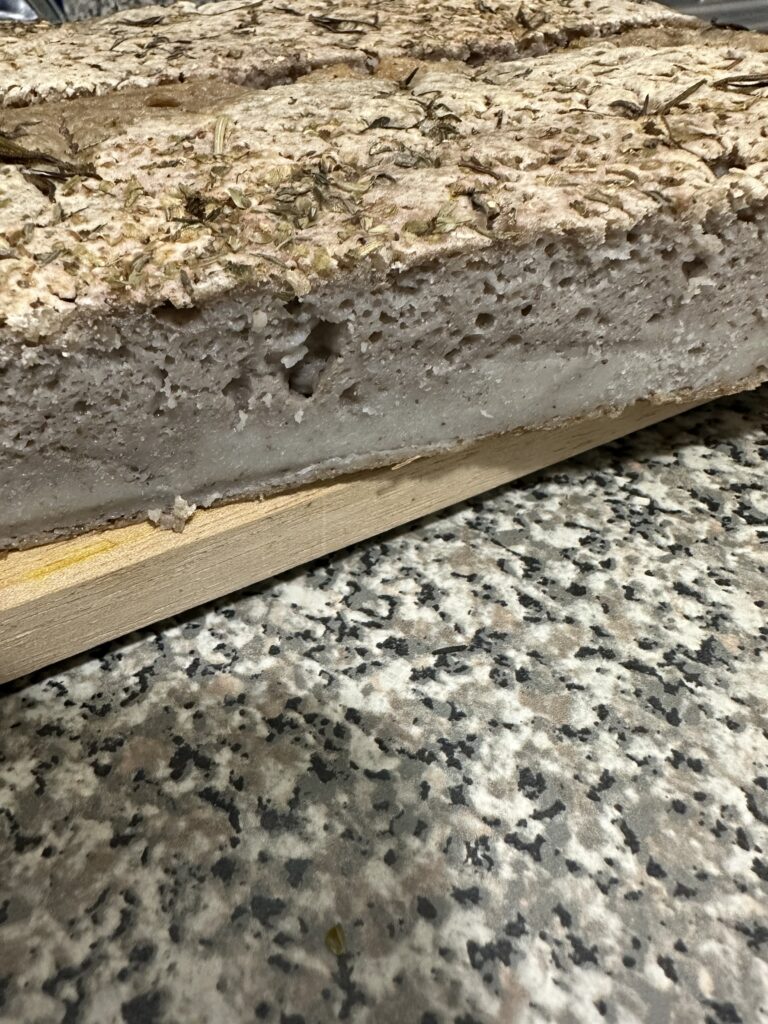
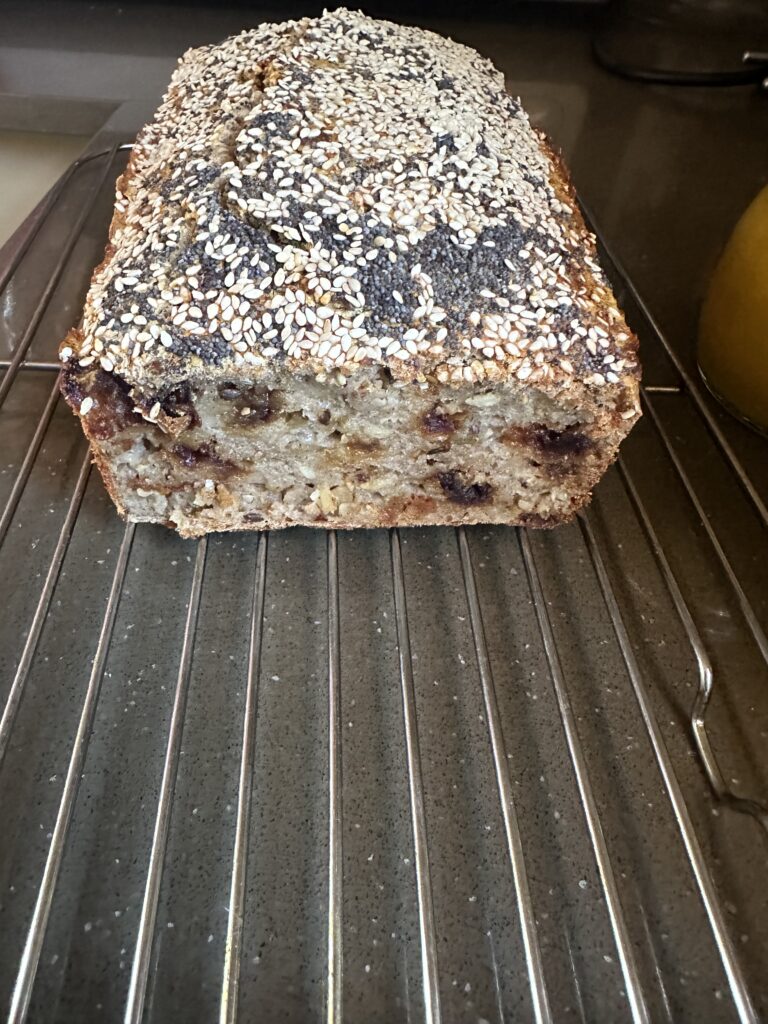








I was wondering if Millet also would work. I’m going to get some Buckwheat and make the bread, but have a big bag of Millet. 🙂
I have not tried, but I’m not sure it would for this exact recipe 🙂
Can I use buckwheat flour. instead of the kernels and what are the proportions then? Thank you
No unfortunately flour won’t work here!
I was unable to cook if after 24 hours due to personal time constraints, so I put it covered in the fridge and baked it about 12 hrs later (36 hours total fermentation). It turned out perfectly!!!! Love this recipe. I couldn’t believe how wonderful this bread is.
That’s good to know, thanks for sharing! So happy you like it 💚
hi! Thanks for sharing this great recipe. Ive just made the bread with a 22 hs fermentation but when I cut it it looks plain without the bubbles I can see in yours. What does that means? I should have it fermented for a shorter time? or longer? can I eat it anyway or it will be too heavy? I have used raw buckwheat.
Thanks!!
Hey Celeste, it sounds like the fermentation might not have happened, you could try to ferment it for the full 24 hours next time. If you enjoy it, it’s still perfectly safe to eat, maybe chopped yp and baked in croutons if it’s a bit too dense. Just checking the buckwheat you used was hulled too?
Hi Sarah, thanks a lot for your prompt reply,
I will give it another try with 24 hs fermentation then.. maybe it was not warm enough in the room too.
Yes, the buckwheat I’ve used was hulled. I managed to get very tiny bubbles but nothing to compare with your perfect bread! All the best.
Anytime! Let me know how your next batch go 💚
Can you allow this to ferment for greater than 24 hours? Would 36-48 hours still be safe to bake and eat?
Hey Kimberly, I have not tried. Someone in the community mentioned decent results with a 36 hours ferment at very low house temp, but did say they got better results at 24 hours ferment with higher house temp. I would recommend keeping it around 24 hours to be safe 🙂
Once it starts to bubble and rise does that mean it’s done fermenting or do you let that happen for a few hours? Mine started bubbling and smelling nice and sour at about 18 hrs & so I put it in fridge and baked it a couple hours later when I had time. But I wonder if I should’ve let it bubble longer…
My first loaf of this bread came out so well that I began baking up three loaves at a time. It freezes perfectly and it’s really handy to have ready to go in the freezer, because I eat ALOT of this bread. It toasts up so great and goes as well with yogurt as it does with soup. I like to make it with cinnamon, cardamom, and ginger right into the batter. I can see myself having this as my go-to bread recipe for the rest of my life! Thank you, Sarah!
Hey Rebecca, I’m so happy to hear that, I also love keeping it in the freezer, so handy! Thank you for your lovely review 🙂
I wish it can work for me. I’ve tried the recipe twice. The second time I made sure to follow everything to a T. When it baked and cooked down, there was a giant air bubble on the bottom, instead small bubbles rising inside of the “bread.”
Hey Kc, does the bread turns out well except for that 1 air bubble? What is your current home temp, how long are you fermenting it for and are you fermenting it straight into the loaf pan?
Hi Sarah! I just want to let you know that I made ur buckwheat bread recipe and it was phenomenal!!!! Thank you for sharing such great
recipe! My entire family loved it! I became gluten free since I found out that I have Hashimoto and I was having a hard time to find gluten
free bread without the bad fillers. Your recipe is delicious and perfect! All
natural and wholesome the way that I like it! Thanks!!❤️❤️❤️❤️
Hey Cristiane, thank you so much for the lovely feedback! I’m so happy to hear you and your family love it 💚
I tried this bread for the first time today, and LOVED it! I have an autoimmune disease and have adjusted my diet to one that is more anti-inflammatory for my body. I successfully reintroduced buckwheat a few months ago and was so excited to try this recipe, as I haven’t had bread for about 7 years. I’m looking forward to experimenting with add-on ingredients – thank you for sharing this recipe!!
Hey Wendy, I’m so happy to hear you loved it and it’s helpful for your diet 💚 I’ve just posted a super easy wrap recipe using the same buckwheat which I think you might find helpful too, let me know if you try it 🙂
https://plantbaes.com/2-ingredient-buckwheat-spinach-wraps-gluten-free/
I love this bread but honestly find it a little dry
Any suggestions ?
Hey Ivy, I’m so happy you love it! You could try adding a bit of olive oil to the blending step. Let me know if you try it 💚
Amazing bread, thank you so much for this recipe Sarah. I was a little concerned about the fermentation process but it was easy. The dough actually rised approx 30% in 22 c Celsius. (24h) I used a steel bowl and not plastic.
I’m very happy you like it 🙂
Hi Sarah, I’m hoping you can help me: I soaked the groats for 7 hours, and I fermented for 24 because it’s currently ~50 outside where I live, and things looked fine enough? But it didn’t rise when I baked it, and I let it cool overnight, but the inside is that awful gummy brick that gluten free tends to turn into. I have no idea what went wrong!
Hey Liam, I’m sorry to hear that. It sounds like it might have been too cold for the fermentation to happen. I would recommend leaving it near a source of heat next time, or wait until the internal temperature is over 20 C in your home. I promise it is well worth giving another go 💚
Also here are some tips to help make the next loaf rise beautifully:
– Use filtered water if the water in your area contains a lot of chlorine, as this will negatively impact fermentation.
– Someone in the community also mentioned fermenting the dough directly in the loaf pan as a tip to get it to rise even more.
Hi! Could you confirm the measurements? I have tried to make this 2 times without success. It seems that the water is not enough and I can’t seem to blend the mixture until smooth, so I think it’s not fermenting and the end product doesn’t cook even though I had it in the oven for 2 hours last time. I used 500 grams of dry buckwheat. How much water should I add for blending?
Hey Lily, the measurement of water to add to the blending steps is 200ml. You could get away with adding a little bit more, up to 30ml
Just checking: are you soaking the buckwheat in a large volume of water for the first step?
Are you using hulled, non-roasted buckwheat (also called green buckwheat in some places)? Roasted or unhulled buckwheat won’t work here, and it’s the most common reason for the bread not cooking thoroughly.
Lastly, if the above is correct, it might be that your blender is not powerful enough. I use a high-speed blender in the recipe. If that’s the case, you can blend at low speed and slowly increase the speed. Take breaks every 20 seconds or so to avoid overheating your blender.
Hi!!
I was wondering if this would cook well in a Dutch oven, I don’t have a bread pan and this just sounds too good not to make asap!
I don’t use a dutch oven, so I can’t advice here, but hopefully someone else will be able to 🙂 I know some people have made mini breads in muffin tray from this recipe if that helps x
Does this bread freeze well?
Yes perfectly, slice before freezing and you can toast a slice whenever you need 🙂
Hi, I made the loaf for a second time and this time added cranberries and walnuts. I am not sure if it was cooked, it looked quite moist not like a typical loaf, but I could tap the base and it ‘sounded’ cooked!! I took it out of my fan-assisted oven after 80 minutes as the crust was super hard. I did slice a little off before it cooled would this have affected the texture of the bread? Or was it because I added the cranberries and walnuts? Thank you
I would recommend cooking for the full 90 minutes, even if the crust seems hard/cooked 🙂 and wait for the bread to be fully cooled before slicing. It will look wetter otherwise.
The .9 c of water doesn’t cover the 2.6c of buckwheat even when i try different size bowls and it says to make sure its fully submerged. So do I use more water?
For the first step cover with as much water as needed, to fill a large bowl and fully submerge the buckwheat. The 0.9 cup is to blend the soaked buckwheat 🙂
Thank you. I realized I jumped to question too quickly after re-reading the .9 c of water was for the blender step. I just baked my loaf tonight and love it! This is a fantastic recipe that will be a staple in my house.
I’m so happy you loved it 🙂💕
What size of loaf pan do you bake the bread in?
24 x 13 x6.5 cm
9.5 x 5 x 2.5 in
Hope you love the bread 💚
Thank you . I just made it today. looking forward to eating some.
I made this bread today, OMG, I live in Queensland and we’ve had very warm weather, I fermented for 24hrs, a slight odour when mixing in my favourite dried fruit and seeds, but mot too bad, cooked as instructed, I thought I had over cooked as the crust seemed very hard, I was tempted to cut but waited for it to cool, perfect! Spread some Natural peanut butter! OMG yum, thank you so much for sharing this recipe Sarah!
I’m so happy you liked it Jenni! What dried fruits did you use? sounds like you added a delicious combo 🙂
Hiya…thankyou for this recipie! I have baked it twice and both times it has not risen at all so both loafs were very flat, only about 2 inches :(. I am in NZ so its pretty hot here but I still did the 24hrs of fermenting.
Cheers Donna
Hey Donna, does the cooked bread have some bubble in it, or is it more compact? Feel free to send me a pic so we can figure out what’s going on 🙂 Depending on the water in your area, using filtered water can make a big difference. You can also try to ferment it directly into the loaf pan, and leave it near a source of heat if the temperature in your home is bellow 25 C.
Hi Sarah, I’m just about to start making the bread, really looking forward to it.
I wanted to ask about the oven temperature. My oven is fan assisted, should I reduce the temperature by 20C as per usual fan to conventional ovens temperatures?
Thanks and many thanks also for sharing your lovely recipes.